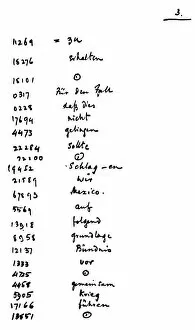Cipher Collection
Cipher: Unlocking the Secrets of Communication Step into the world of cipher, where hidden messages and encrypted codes intertwine with history and innovation
All Professionally Made to Order for Quick Shipping
Cipher: Unlocking the Secrets of Communication Step into the world of cipher, where hidden messages and encrypted codes intertwine with history and innovation. This captivating concept has fascinated minds for centuries, from the brilliant British mathematician Alan Turing to unexpected figures like Princess Elizabeth as Colonel of the Grenadier Guards in 1942. The crown and royal monogram symbolize power and secrecy, reminding us that even those in high positions have relied on ciphers to protect their sensitive information. Travel back further in time, and you'll encounter intriguing 16th-century codes such as the Babington cipher, which played a significant role during tumultuous times. Imagine an inlaid and carved open armchair encoded with a patchwork of various phrases—a tangible representation of how they can be seamlessly integrated into everyday objects. Such craftsmanship speaks volumes about the creativity employed to safeguard secrets throughout history. As we explore further, we stumble upon memorials like that dedicated to poet and doctor Colonel John McCrae—a reminder that cryptography not only impacts military strategy but also serves as a tribute to those who fought valiantly for their countries. In Kenny Meadows' engraving titled "The Country Schoolmaster, " we witness knowledge being passed down through generations—an essential aspect when it comes to understanding complex cryptographic techniques. From U. S. Troops learning cryptography in Papua New Guinea during World War II to illustrations found within books like Cryptomenysis and Cryptography—each image tells a story of dedication towards mastering this intricate art form. Delve deeper into historical artifacts adorned with ciphers—the carved oak armoire bearing Lambert Suavius's cipher or the intricately designed oak table—both showcasing how individuals left their mark by embedding secret symbols within functional pieces. Finally, let's not forget Charles Wheatstone—an engraving capturing his contribution as one of history's foremost cryptographers. His brilliance paved the way for modern encryption methods still used today. Cipher: A testament to human ingenuity, secrecy, and the unending quest for knowledge.






































